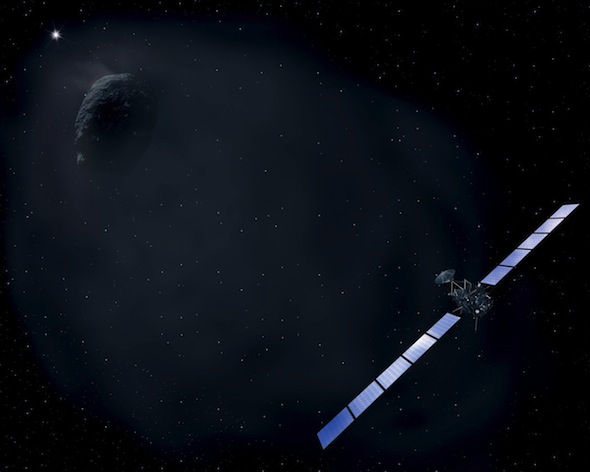
An artist's impression of Rosetta waking from deep-space hibernation to rendezvous with Comet 67P/Churyumov-Gerasimenko in 2014. © ESA, image by AOES Meidalab.
In May, the Rosetta spacecraft will make its final approach toward the comet 67P/Churyumov–Gerasimenko, after patiently stalking the space rock for ten years. As the comet approaches its perihelion, it will slow to dig its foot into a gravitational eddy and steer itself around the sun. As it emerges, Rosetta will strike, launching a sensor-packed lander like a javelin into the side of the comet. Harpooned in place, the lander will allow us to reach out across the cosmos and caress a billion-year-old piece of the solar system.
The experiments are scheduled to last two months, after which Churyumov–Gerasimenko will have arced around the sun and begun accelerating back out into deep space. When it does, it will take with it a small piece of humanity anchored to its side. Forever after, this relic of early 21st century technology will remain looping above us, a time capsule buried ten years deep in space.
The apparatuses of our space explorations invariably become monuments to the missions they served. When they're no longer of use, they are discarded and left to blanch slowly in the airless sunlight. Rosetta is only the latest in a long series of inadvertent time capsules bequeathed to the heavens. At the Sea of Tranquility, Apollo 11's landing stage still stands as a memorial to that incredible journey. At its feet, the rocket-blasted shoes, camera, backpacks and other equipment that Armstrong and Aldrin cast away to lighten the lunar module before launching homeward.
These abandoned machines are some of our most perfect time capsules. They show our society at its most candid, a transparent expression of our technology, our financial might, our social ambitions. Unlike the Pioneer plaque, with its sanitised view of humanity—see the diminutive woman airbrushed of her genitals—or Trevor Paglen's poignant Last Pictures, which orbits on the satellite EchoStar XVI, these machines are devoid of political or social framing and filtering.

Gold aluminium cover designed to protect the Voyager 1 and 2 Sounds of Earth gold-plated records from micrometeorite bombardment, including playback diagram.
They are a piece of our world captured and buried away from us. When they eventually resurface, entire and unadulterated, they can be a mirror in which we see ourselves distantly reflected.
Already, the historical value of technological artefacts is obvious. The Google Lunar X Prize for the first commercial sightseers to reach the moon offers a $1 million bonus for any competitor that visits a historic site on its desolate surface, the first tourists at Tranquility's shores. Meanwhile, Amazon CEO Jeff Bezos combed the ocean depths off the coast of Florida for abandoned parts of the Apollo 11 mission, eventually raising a pair of rocket engines from 14,000 feet of water. But what will the value of such artefacts in a thousand years? Five thousand years? Will we hold them in as much awe and wonder as the Pyramids when they are as old as those monuments are now?
Among the artefacts of our civilization, the comet probe is a special case: outside of the corrosive effects of Earth's atmosphere, semi-protected from collision with orbiting space junk, and so-far inaccessible to space tourists. While technologically challenging, there is no outward reason why Apollo's rockets couldn't have been recovered sixty years ago. Quite obviously we have the technological capacity to visit the moon—we've simply lost the will to go there. But Churyumov–Gerasimenko's long orbit will offer us only a tiny window every six and a half years in which we might, if we set off ten years before that, recover the Rosetta lander. As a time capsule, the Apollo rockets were never far from reach, and the Tranquility Base junkyard is where we left it. But the Churyumov–Gerasimenko time capsule can only be opened every 78th month.
By astronomical standards that's positively frequent. If we were to inter a time capsule on one of the comets launched from the Oort Cloud on galactic tides, we could set aside a message for ourselves one thousand years, ten thousand years, a million years in the future.
The tools that now lay discarded and forgotten across a narrow strip of the cosmos will one day tell someone as much about us as they told us about the planet, the moon, the stars. The pinnacles of our technological achievements are destined to become ruin. Instead of a thriving outpost, we left a technological footprint on the moon, a set of vast and trunkless legs in the desert. Our legacy there is not a thriving extension of the United States' empire, but an inert memorial built from mid-20th century technology.
If our exploratory machines are destined to become accidental monuments to their makers, perhaps we ought to be conscious of this in their design. Could the physical construct of the Apollo lunar modules exemplify peace for all mankind? Should a celebration of liberté, égalité, fraternité and the free market be encoded into the fabric of the Channel Tunnel boring machines, still buried in the chalk marl under the seaway? Can Rosetta evoke its namesake?
The Rosetta spacecraft is named for the huge slab of black granite pulled from the Nile mud inscribed with the text of three distant empires, a cipher with which we could decode the lost history of Egypt. When it was first discovered, a postscript was added in white paint to the side: "Captured in Egypt by the British Army in 1801," it reads, "Presented to King George III." When Rosetta's harpoon lands like a stylus on Churyumov–Gerasimenko, we'll add our own chapter to the billion-year-old story encoded in the stone. Look here, we'll tell our descendents, see this strata of carbon fibre and lenses, this was when your forefathers explored the heavens. We'll add our own footnote to the history of the solar system and cast it back into the interplanetary mud for some future human to find.

